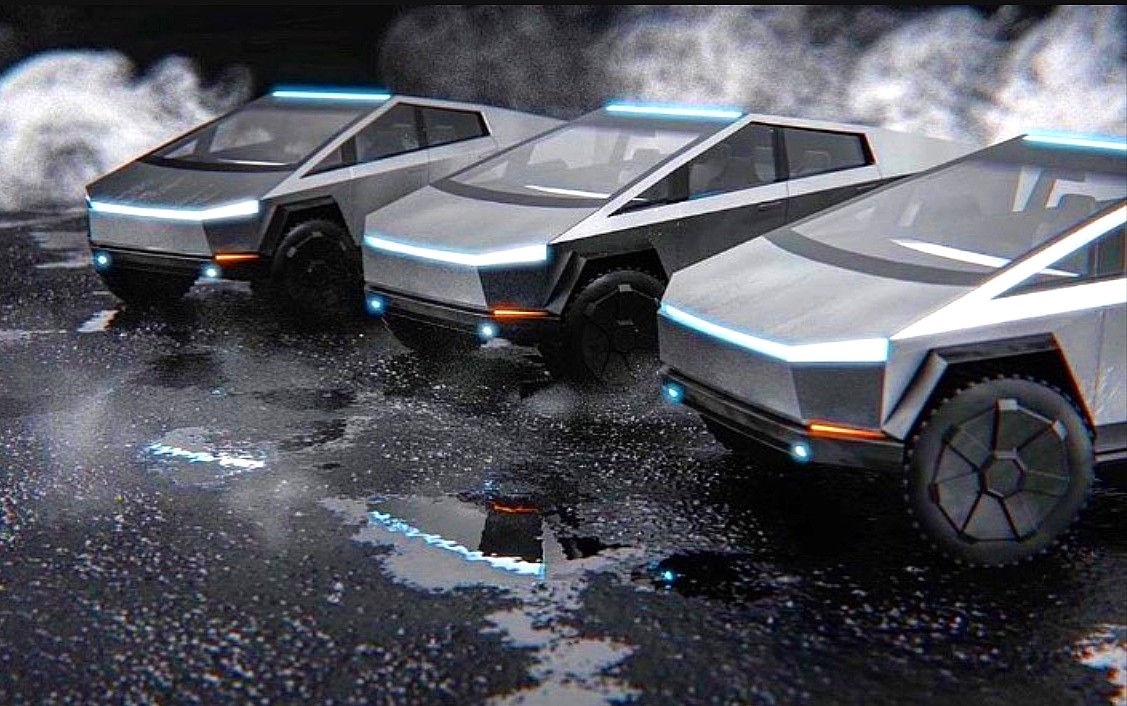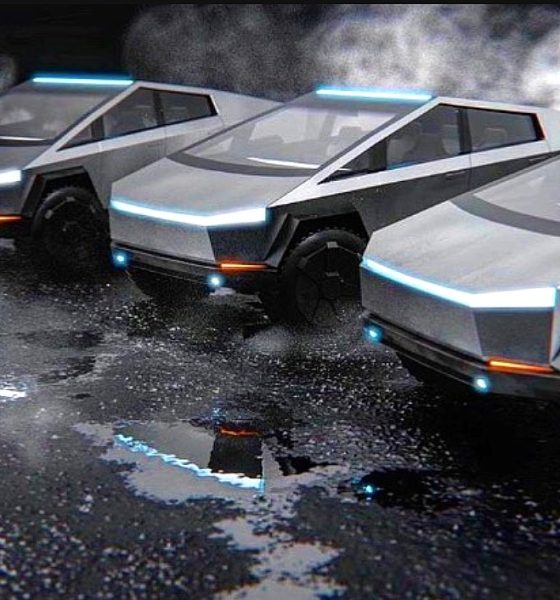

News
Tesla Cybertruck is in the crosshairs of many but Elon Musk isn’t worried
There is a point to be argued that the attention attracted by the Tesla Cybertruck is a double-edged sword. Granted, the vehicle has captured the interest of both the EV and traditional auto community primarily due to its stark XY design, but with this comes a ton of scrutiny from all sides. And in the months since its unveiling, the Cybertruck has received a healthy dose of scrutiny.
Critics pointing out negatives about Tesla’s upcoming vehicles is nothing new, and in the Cybertruck’s case, some of these were unfounded. Yet there were valid concerns about the vehicle. The truck is massive, for example, to the point where AR simulations of the vehicle indicated that it would not fit in an average 20×20 garage in the United States. Others, interestingly enough, questioned the vehicle’s capabilities as a legitimate off-roader due to its weight.
In true Tesla fashion, the electric car maker appears to have taken it upon itself to make sure that it addresses these criticisms. Elon Musk, for one, noted in a recent Twitter post that the Cybertruck’s production version would be about 3% smaller than the vehicle featured at the unveiling. Such a reduction will likely not affect the spaciousness or utility of the all-electric pickup, but it will enable the Cybertruck to fit in conventional garages.
This automatically opens up a whole new market for the Cybertruck. Following its unveiling, members of the Tesla community who were fortunate enough to experience a test ride in the vehicle noted that the Cybertruck is incredibly large. Thus, it did not take long before reservation holders indicated that they would likely keep the truck outside their garage due to its size. With a 3% reduction in size, this does not have to be the case.
Adjustments to the Cybertruck’s window sill height also makes the vehicle less intimidating for both passengers and drivers. With a lower window sill height, the Cybertruck will feel less like a vehicle that’s essentially swallowing its occupants. For territories beyond the US where large trucks are not as common, this particular detail would likely be appreciated by potential buyers.
Apart from adjustments to its size, Elon Musk mentioned that the Cybertruck’s air suspension system would be completely different from those used in the Model S and Model X. This suggests that unlike the two flagships, both of which are designed for the city, the Cybertruck’s suspension is intended to be used under rough and tough conditions. Musk said as much, stating that the Cybertruck is being designed to dominate in events like the Baja 1000, an off-road racing series where the auto industry’s best trucks compete against each other.
Just recently, truck enthusiasts from The Fast Lane Car YouTube channel expressed their doubts about the Cybertruck’s off-road capability due to the vehicle’s “monstrous” weight and lack of low-speed gearing. The hosts even mentioned the vehicle’s ground clearance. This is quite surprising as the Cybertruck’s 16″ ground clearance dwarfs that of popular trucks like the Ford F-150 Raptor, matching monster trucks like the Hummer H1, a military vehicle that’s pretty much just converted for civilian use.
One thing that critics are prone to forget is the fact that Tesla never remains in one place. Yes, the Cybertruck may be a bit too large when it was unveiled, but this does not mean that its size could not be reduced. The vehicle may look heavy and daunting, but perhaps it would be lighter than expected when it gets to production thanks to better battery technology. And with suspension improvements hinted at by Elon Musk, the Cybertruck could very well set the standard for all-electric off-road vehicles for years to come.
It is easy to dismiss Tesla’s efforts because of the company’s lack of experience compared to veterans in the auto industry. But underestimating Tesla is a grave mistake. One just needs to look at the premium midsize sedan market to see this point. Prior to the Model 3, for example, the BMW 3-Series seemed like a wall that could not be broken. As it turned out, even established cars like the BMW M3 could be bested, and later, even dominated. With this in mind, popular off-roaders today are best advised not to underestimate the Cybertruck.

News
Tesla starts showing how FSD will change lives in Europe
Local officials tested the system on narrow country roads and were impressed by FSD’s smooth, human-like driving, with some calling the service a game-changer for everyday life in areas that are far from urban centers.

Tesla has launched Europe’s first public shuttle service using Full Self-Driving (Supervised) in the rural Eifelkreis Bitburg-Prüm region of Germany, demonstrating how the technology can restore independence and mobility for people who struggle with limited transport options.
Local officials tested the system on narrow country roads and were impressed by FSD’s smooth, human-like driving, with some calling the service a game-changer for everyday life in areas that are far from urban centers.
Officials see real impact on rural residents
Arzfeld Mayor Johannes Kuhl and District Administrator Andreas Kruppert personally tested the Tesla shuttle service. This allowed them to see just how well FSD navigated winding lanes and rural roads confidently. Kruppert said, “Autonomous driving sounds like science fiction to many, but we simply see here that it works totally well in rural regions too.” Kuhl, for his part, also noted that FSD “feels like a very experienced driver.”
The pilot complements the area’s “Citizen Bus” program, which provides on-demand rides for elderly residents who can no longer drive themselves. Tesla Europe shared a video of a demonstration of the service, highlighting how FSD gives people their freedom back, even in places where public transport is not as prevalent.
What the Ministry for Economic Affairs and Transport says
Rhineland-Palatinate’s Minister Daniela Schmitt supported the project, praising the collaboration that made this “first of its kind in Europe” possible. As per the ministry, the rural rollout for the service shows FSD’s potential beyond major cities, and it delivers tangible benefits like grocery runs, doctor visits, and social connections for isolated residents.
“Reliable and flexible mobility is especially vital in rural areas. With the launch of a shuttle service using self-driving vehicles (FSD supervised) by Tesla in the Eifelkreis Bitburg-Prüm, an innovative pilot project is now getting underway that complements local community bus services. It is the first project of its kind in Europe.
“The result is a real gain for rural mobility: greater accessibility, more flexibility and tangible benefits for everyday life. A strong signal for innovation, cooperation and future-oriented mobility beyond urban centers,” the ministry wrote in a LinkedIn post.
News
Tesla China quietly posts Robotaxi-related job listing
Tesla China is currently seeking a Low Voltage Electrical Engineer to work on circuit board design for the company’s autonomous vehicles.

Tesla has posted a new job listing in Shanghai explicitly tied to its Robotaxi program, fueling speculation that the company is preparing to launch its dedicated autonomous ride-hailing service in China.
As noted in the listing, Tesla China is currently seeking a Low Voltage Electrical Engineer to work on circuit board design for the company’s autonomous vehicles.
Robotaxi-specific role
The listing, which was shared on social media platform X by industry watcher @tslaming, suggested that Tesla China is looking to fill the role urgently. The job listing itself specifically mentions that the person hired for the role will be working on the Low Voltage Hardware team, which would design the circuit boards that would serve as the nervous system of the Robotaxi.
Key tasks for the role, as indicated in the job listing, include collaboration with PCB layout, firmware, mechanical, program management, and validation teams, among other responsibilities. The role is based in Shanghai.
China Robotaxi launch
China represents a massive potential market for robotaxis, with its dense urban centers and supportive policies in select cities. Tesla has limited permission to roll out FSD in the country, though despite this, its vehicles have been hailed as among the best in the market when it comes to autonomous features. So far, at least, it appears that China supports Tesla’s FSD and Robotaxi rollout.
This was hinted at in November, when Tesla brought the Cybercab to the 8th China International Import Expo (CIIE) in Shanghai, marking the first time that the autonomous two-seater was brought to the Asia-Pacific region. The vehicle, despite not having a release date in China, received a significant amount of interest among the event’s attendees.
Elon Musk
Elon Musk and Tesla AI Director share insights after empty driver seat Robotaxi rides
The executives’ unoccupied tests hint at the rapid progress of Tesla’s unsupervised Robotaxi efforts.

Tesla CEO Elon Musk and AI Director Ashok Elluswamy celebrated Christmas Eve by sharing personal experiences with Robotaxi vehicles that had no safety monitor or occupant in the driver’s seat. Musk described the system’s “perfect driving” around Austin, while Elluswamy posted video from the back seat, calling it “an amazing experience.”
The executives’ unoccupied tests hint at the rapid progress of Tesla’s unsupervised Robotaxi efforts.
Elon and Ashok’s firsthand Robotaxi insights
Prior to Musk and the Tesla AI Director’s posts, sightings of unmanned Teslas navigating public roads were widely shared on social media. One such vehicle was spotted in Austin, Texas, which Elon Musk acknowleged by stating that “Testing is underway with no occupants in the car.”
Based on his Christmas Eve post, Musk seemed to have tested an unmanned Tesla himself. “A Tesla with no safety monitor in the car and me sitting in the passenger seat took me all around Austin on Sunday with perfect driving,” Musk wrote in his post.
Elluswamy responded with a 2-minute video showing himself in the rear of an unmanned Tesla. The video featured the vehicle’s empty front seats, as well as its smooth handling through real-world traffic. He captioned his video with the words, “It’s an amazing experience!”
Towards Unsupervised operations
During an xAI Hackathon earlier this month, Elon Musk mentioned that Tesla owed be removing Safety Monitors from its Robotaxis in Austin in just three weeks. “Unsupervised is pretty much solved at this point. So there will be Tesla Robotaxis operating in Austin with no one in them. Not even anyone in the passenger seat in about three weeks,” he said. Musk echoed similar estimates at the 2025 Annual Shareholder Meeting and the Q3 2025 earnings call.
Considering the insights that were posted Musk and Elluswamy, it does appear that Tesla is working hard towards operating its Robotaxis with no safety monitors. This is quite impressive considering that the service was launched just earlier this year.








